This morning started with
breakfast in the motel's dining room. Then it was a short
walk across S. Main Street ( US Rt 4) to the Holiday Inn to
board the bus for today's tour. Heritage Tour - Vermont
Products and Parks Tour was scheduled to leave the Holiday
Inn at 7:45AM with first stop at the King Arthur Flour, then
next stop at the Simon Pearce glassblowing then lunch at the
Quechee Gorge State Park and ending up at our last stop at
the Calvin Coolidge State Historic Site.
At 9:30 AM, we arrived at The King Arthur
Flour Baking Education Center, Bakery and The Baker's Store
at 135 SR 5S which draws visitors from all over the United
States and Canada.
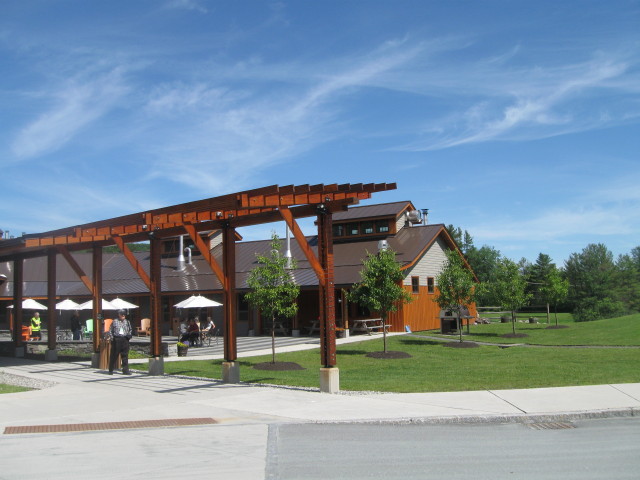
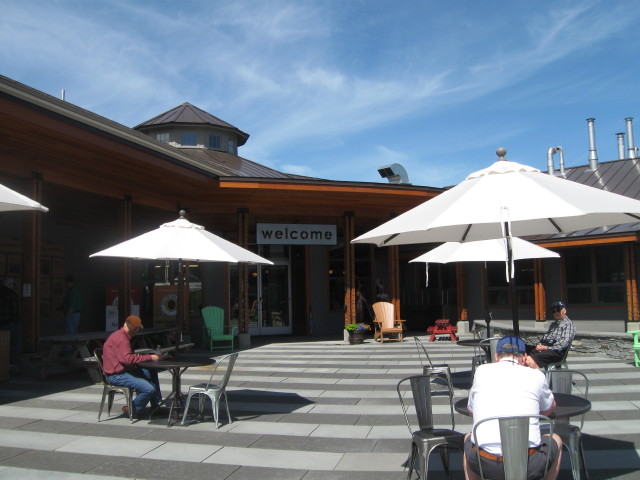
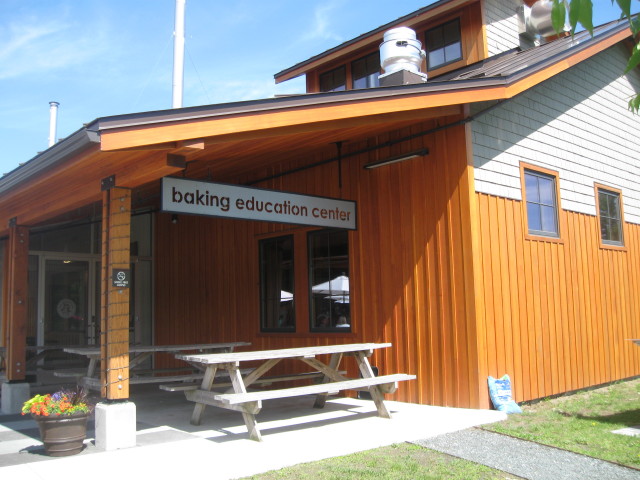
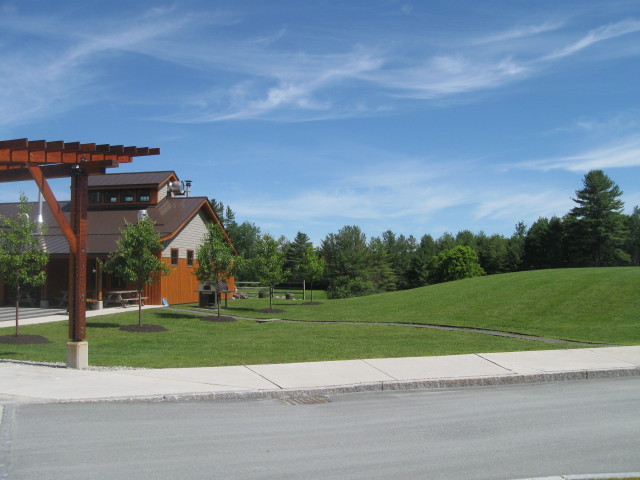
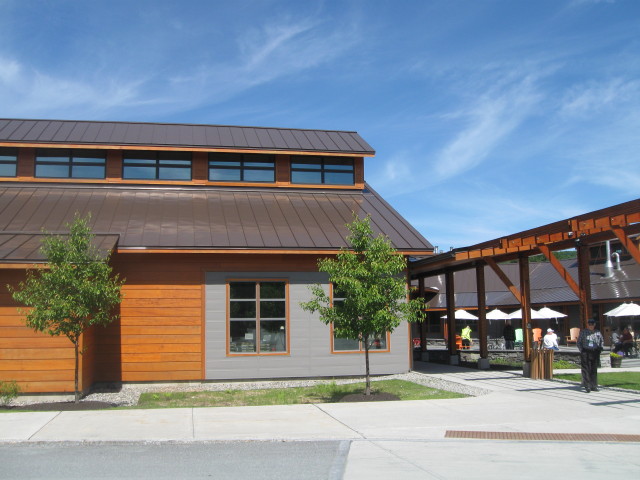
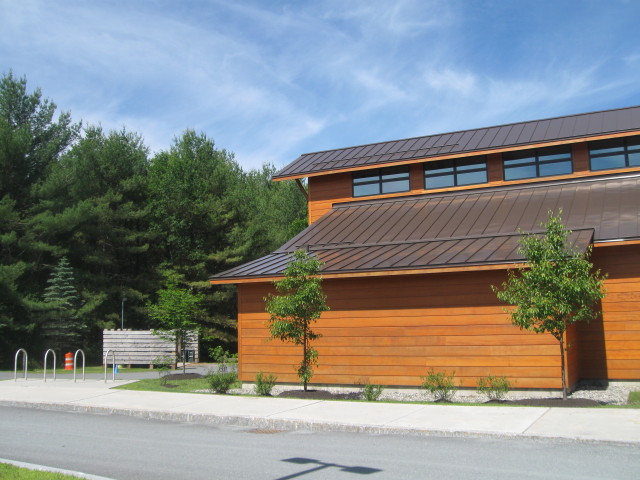
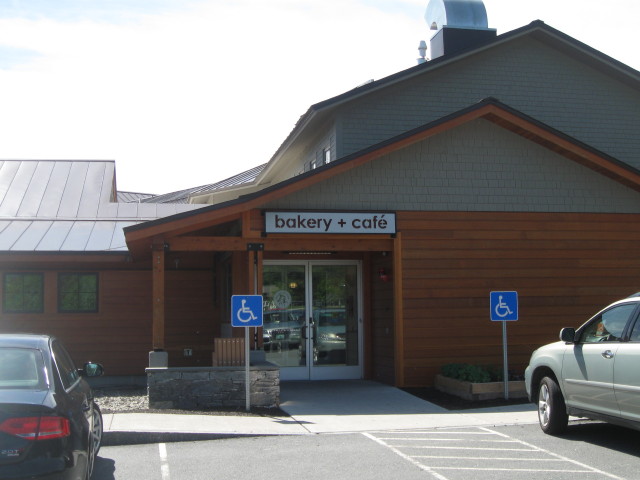
The store is staffed
with experienced bakers who delight in answering
technical baking questions and are quick to provide
demonstrations and samples.
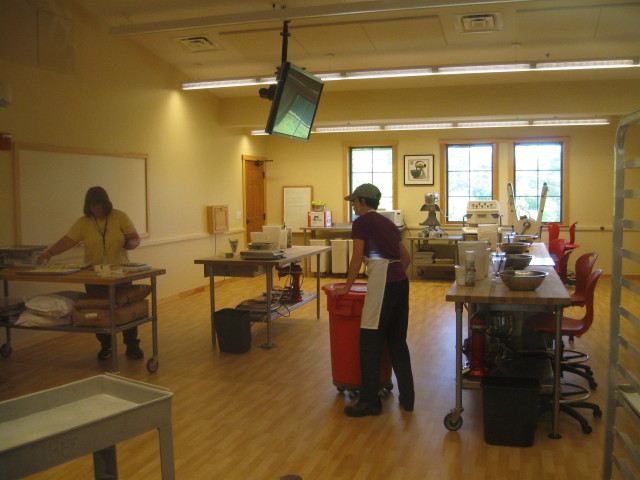
Classroom.
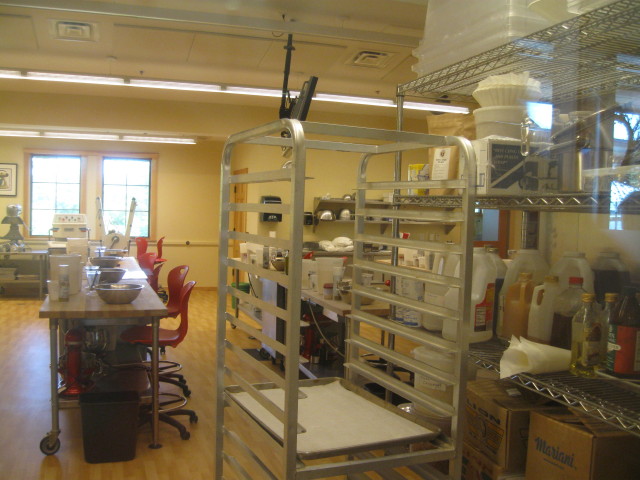
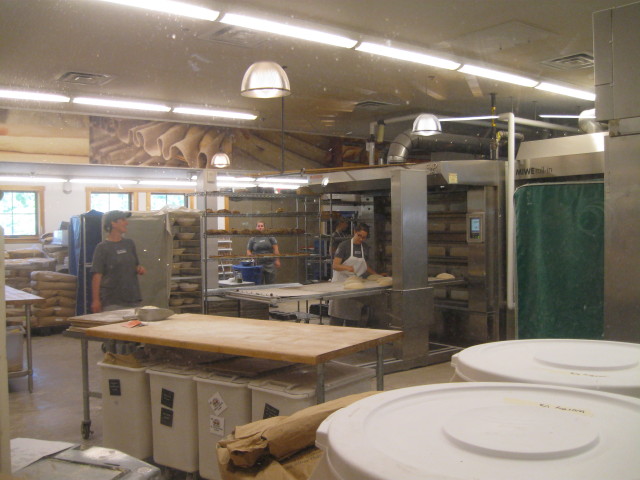

In 1984, King Arthur
Flour located its new headquarters in Norwich, Vermont,
where the company is currently headquartered. Today,
King Arthur Flour is America's oldest flour company,
having been founded in Boston in 1790. In that year,
Henry Wood began importing European flour to Boston,
with the goal of providing high-quality flour for area
bakers.
King Arthur Flour website states that
"we're the nation's premier baking resource, offering
everything from top-quality baking products to inspiring
educational programs - all backed by the passion and
commitment of our dedicated employee-owners." King
Arthur Flour didn't take that name until 1896, when it
was given the new brand name when introduced at the
Boston Food Fair. One hundred years later, the owners,
Frank and Brinna Sands, decided to sell the company to
their employees and began an Employee Stock Ownership
Plan.
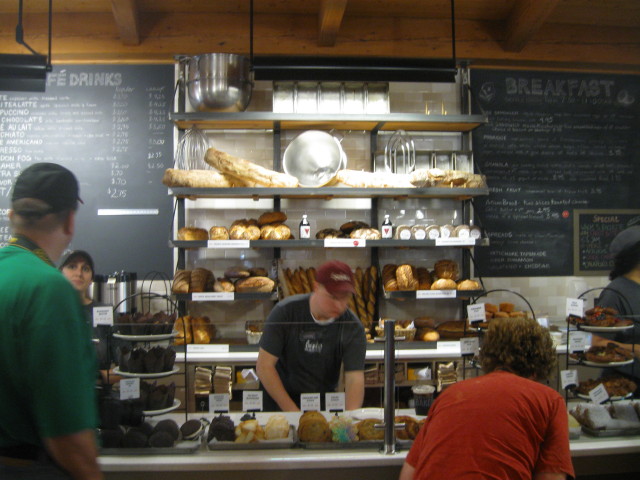
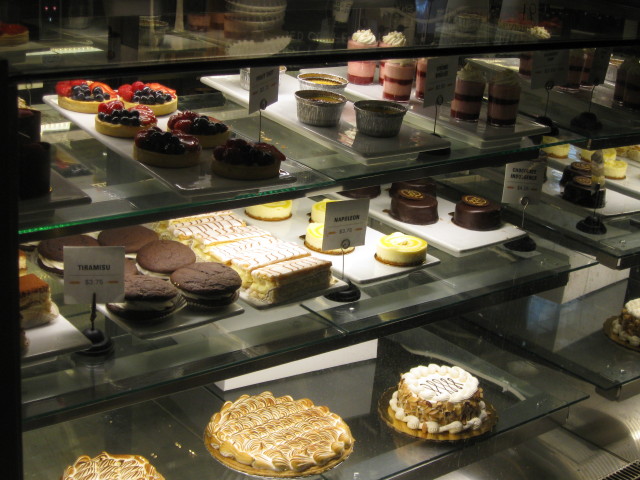
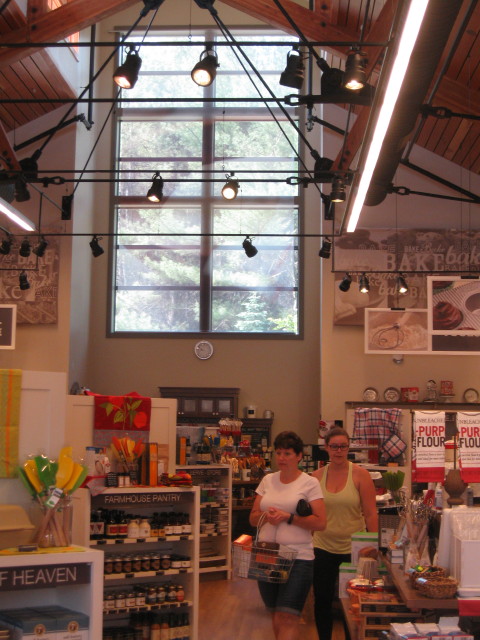
Today's King Arthur Flour Bakery and Store includes
thousands of ingredients, tools, and pans, in addition to
their various flour products.
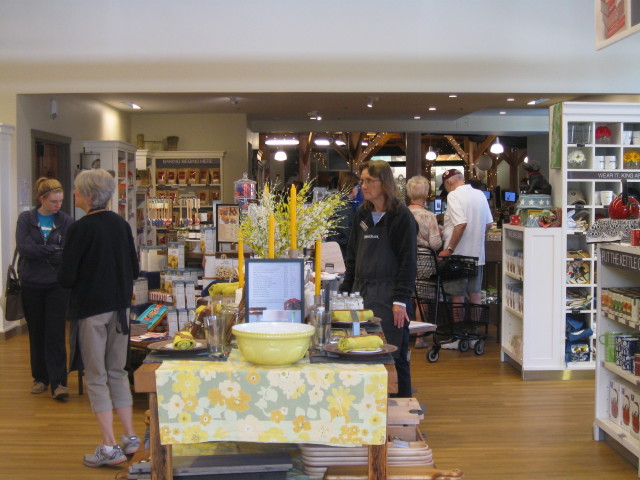
Looking for a souvenir that would not take much room in my
luggage, I bought two jars of Blake Hill Preserve, a
Blueberry & Lemon, and a Strawberry & Rhubarb.
Both of which I learned on returning home were excellent
preserves made in Grafton, VT 05146.
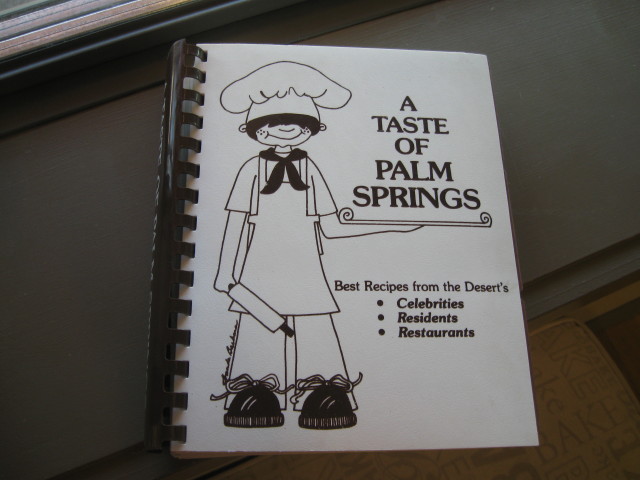
Here in Vermont, a cookbook for my Palm Springs friends.
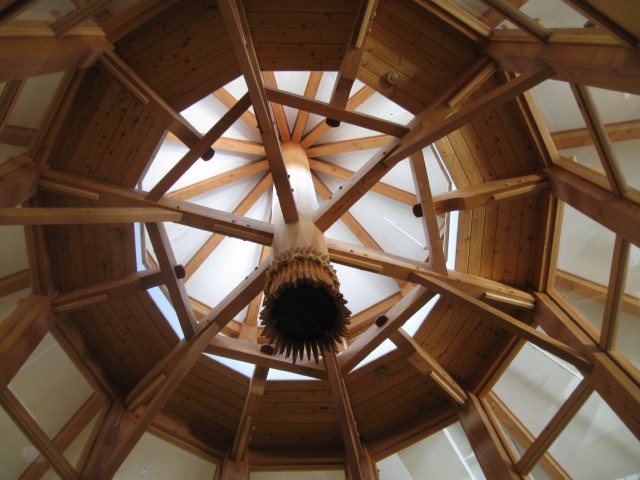
Looking up the rotunda.
After we all
filled our shopping bags, it was time to board the bus
for our next stop. Simon Pearce glassblowing in Quechee,
VT.
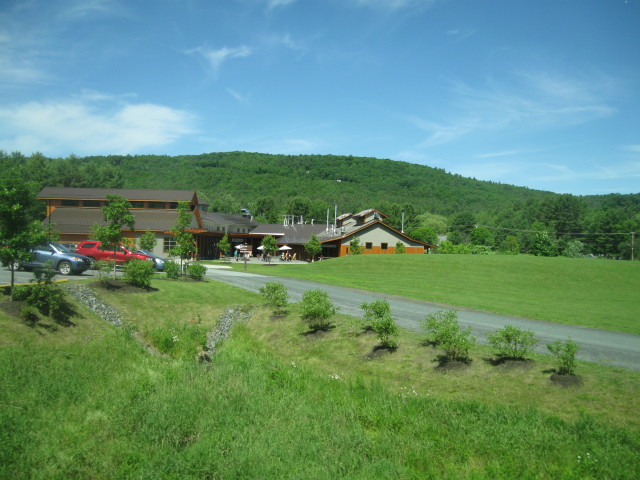
Last look as we depart King Arthur Flour in Norwich,
Vermont.
After a scenic
half hour bus ride, we arrive at our next stop.
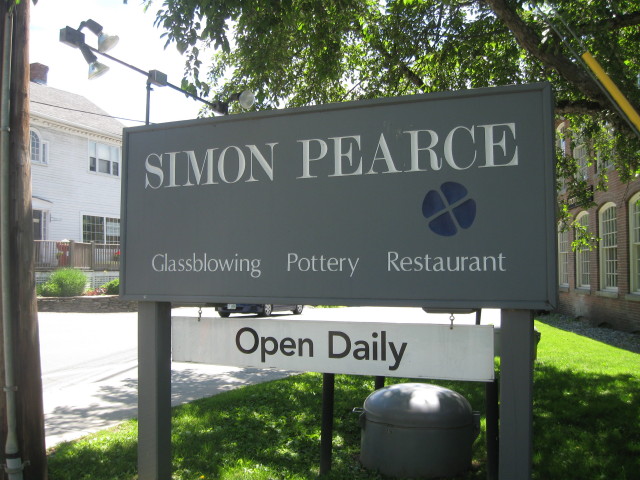
The
work of Simon Pearce has been called some of the
leading glass designs in the world, resulting in
it being given to foreign dignitaries and to
presenters at the Academy Awards. Simon Pearce
began his glass and pottery work in 1971 when he
opened his first glassblowing workshop in
Kilkenny, Ireland. A decade later, he was tired
of the high cost and regulatory environment of
Europe and moved to Quechee, Vermont. He bought
the remains of the former woollen mill and
rebuilt it into his new studio using
hydroelectric power from the Ottauquechee River
to power the entire complex.
With the opening of the
glassblowing studio, Simon Pearce also opened
the Glassblower Cafe. with views of the
Ottauquechee River and a covered bridge.
Visitors can also view the hydroelectric
turbine, interact with the teams of
glassblowers, and shop in the retail store.
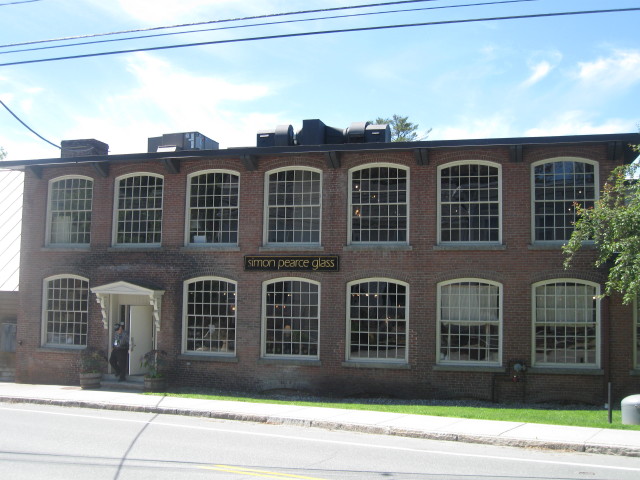
1760 Quechee Main Street, Quechee. VT.
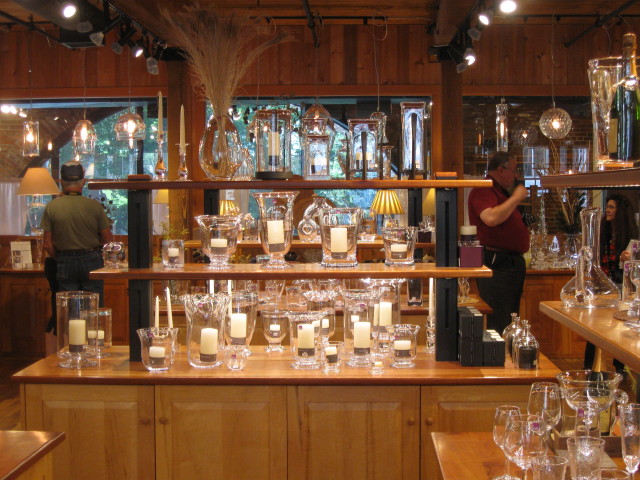
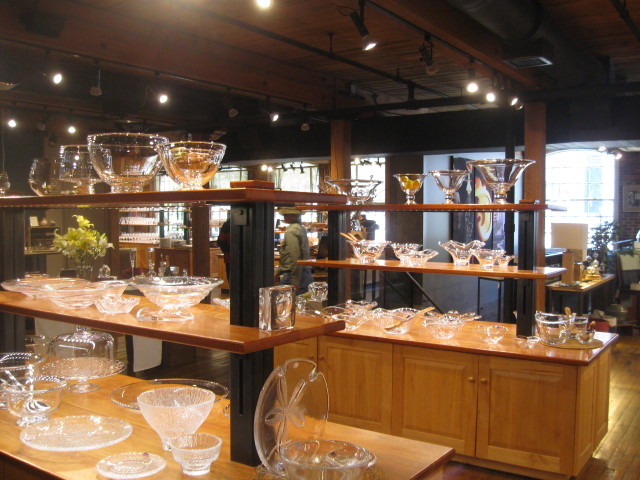
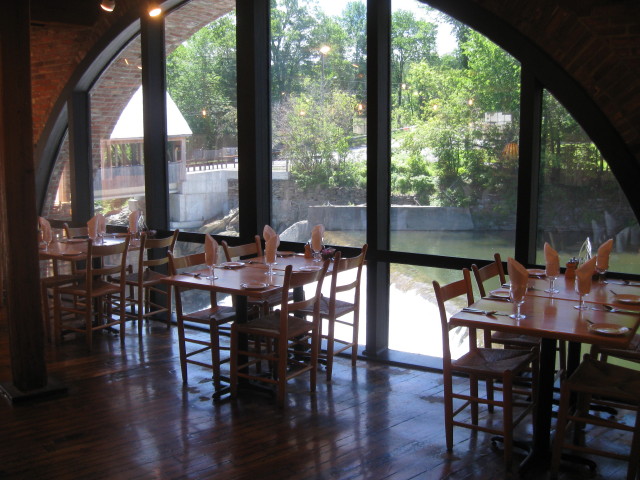
Excellent view of the Ottauquechee River, falls and the
Quechee covered bridge from your table.
Downstairs, under the
retail store and cafe, is located the glassblowing
workshop.
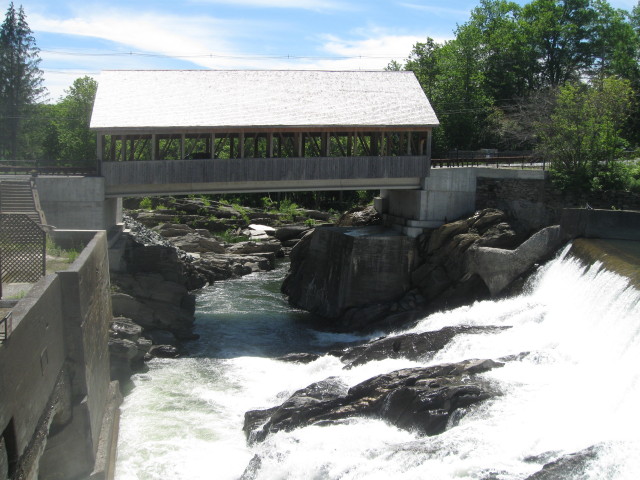
View of falls from the workshop level.
Returning upstairs to
the retail shop, I stopped at the seconds display. To my
untrained eye they all looked exquisite to me.
Disappointed now that I didn't buy something and have it
shipped home.
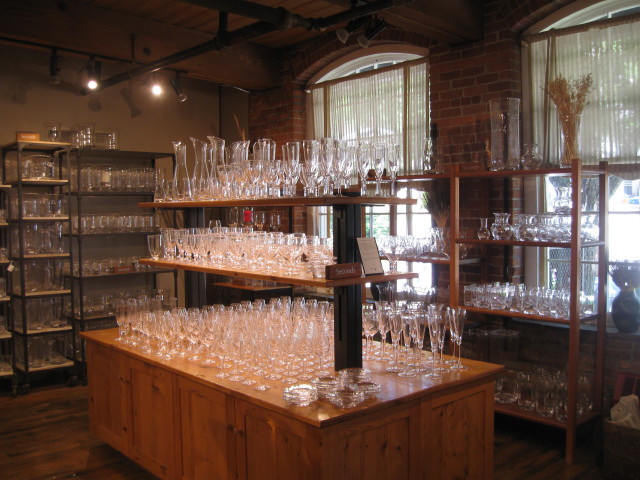
I was most surprised by how heavy the glass items were.
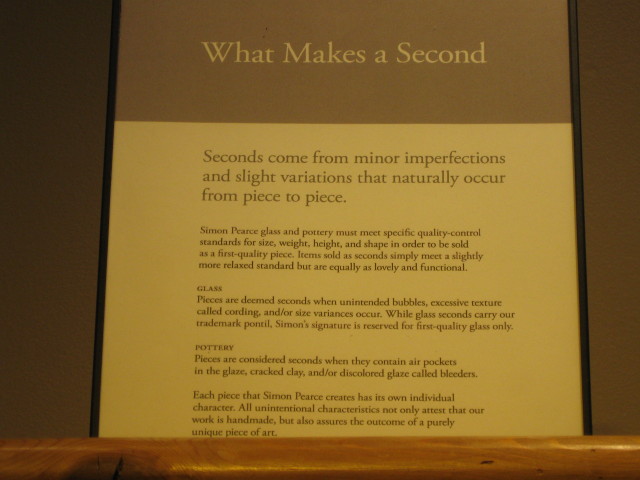
Now let's get a closer
look at that covered bridge.
Our time here was
running short and it was time to locate the bus and travel
to our next stop.
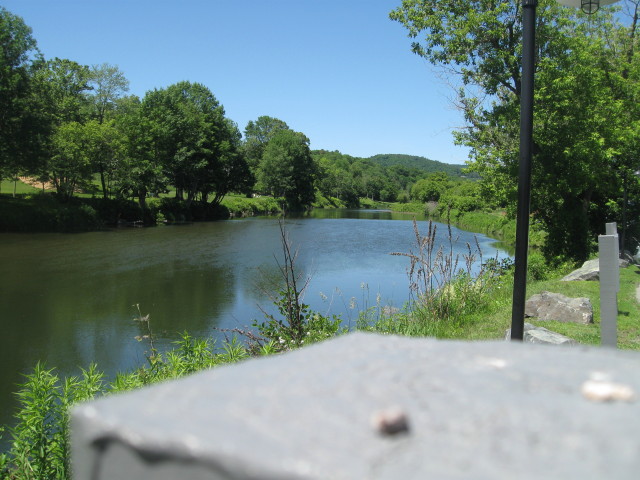
Looking up the Ottauquechee River.
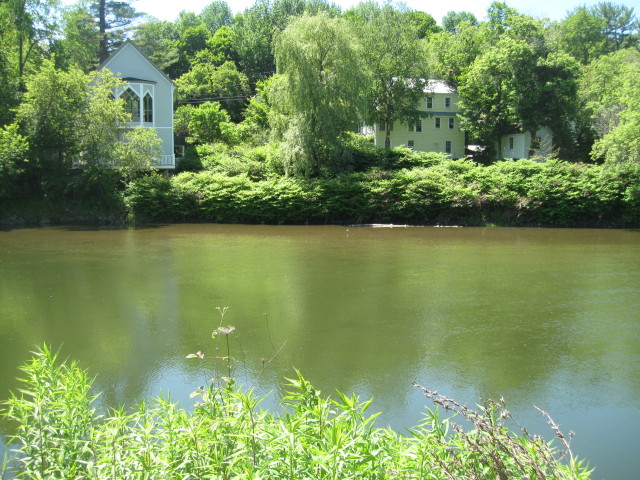
Across the Ottauquechee River.
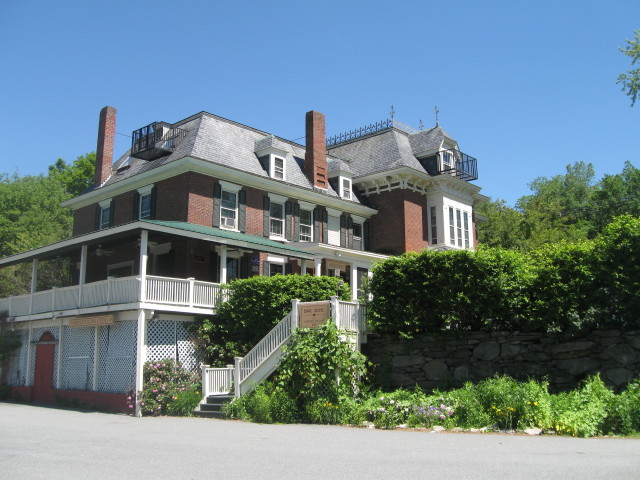
Parker House Inn & Bistro, Bar Irene, located next
to Simon Pearce.
This restored 1857 Victorian-style inn is on the
National Register of Historic Places.
The chef-owner prepares innovative dishes using only the
freshest, local grown produce.
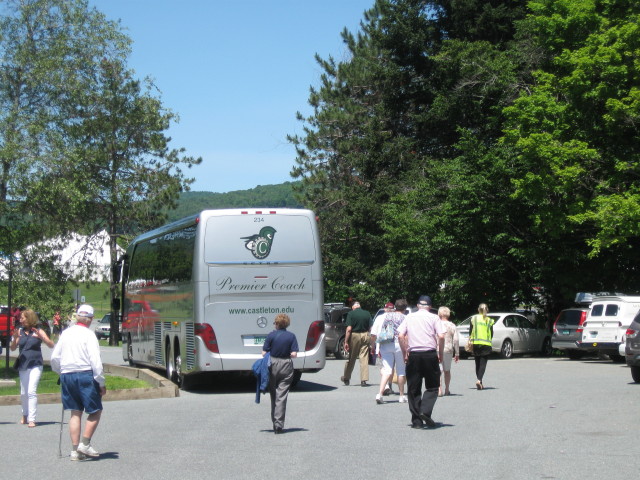
Rounding up the bus riders.
Our next stop was
at the Quechee Gorge State Park and adjacent Quechee
Gorge Village.
Quechee Gorge, known as "Vermont's
Little Grand Canyon," is Vermont's deepest gorge,
formed by glacial activity approximately 13,000 years
ago and now the route of the Ottauquechee River. The
river is approximately 165 feet below the many viewing
points along the canyon walls.
This area was originally owned by
the A. G. Dewey Company, a major wool processor who
settled here in 1869. He soon established a woolen
mill, employing as many as 500 people. Water from
falls and the mill pond just above the gorge were to
power the facility. The mill saw few changes over the
years, and was reportedly one of the oldest woolen
mills in the country by the 1930's. Some of the
material made here was used to make baseball uniforms
for the Boston Red Sox and the New York Yankees, and
blankets for the US Army and Navy.
In 1952, the mill closed and
soon after nearly all of the mill houses and buildings
were demolished. Remains of mill and dam can still be
seen at the head of the gorge. Quechee Gorge State
Park began almost as soon as the mill closed. The US
Army Corps of Engineers began taking land in the area
in 1952 as part of a large flood control plan, which
included the construction of the North Hartland Dam.
Construction of the campground and picnic areas began
later, in the spring of 1962. In 1965, the park was
leased by the State of Vermont and turned over to the
Department of Forests, Parks and Recreation. Today,
Quechee Gorge State Park is one of the most visited in
the state.
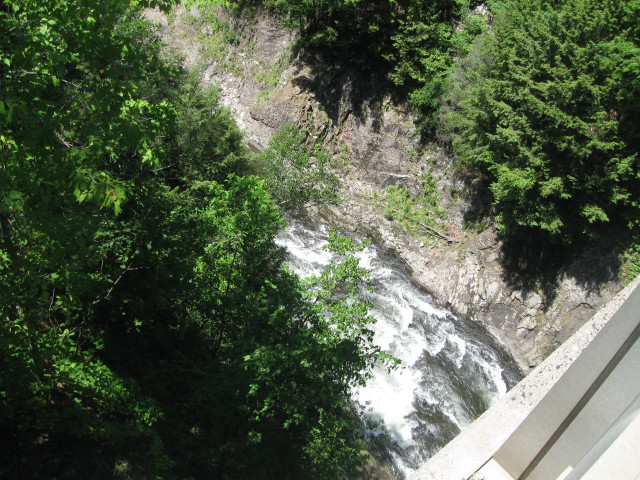
Looking down 165 feet to the Ottauquechee River from
the bridge on US 4.
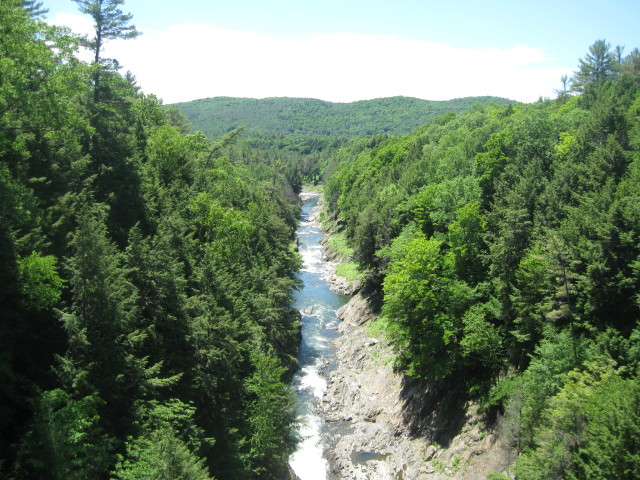
Looking down river.
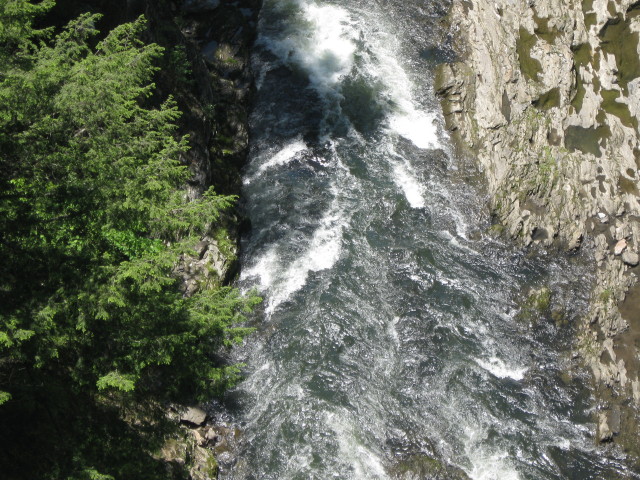
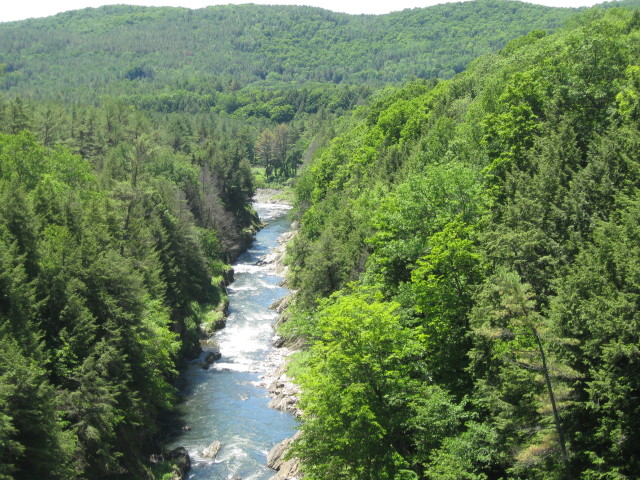
Looking down river in the
GREEN
Mountain state.
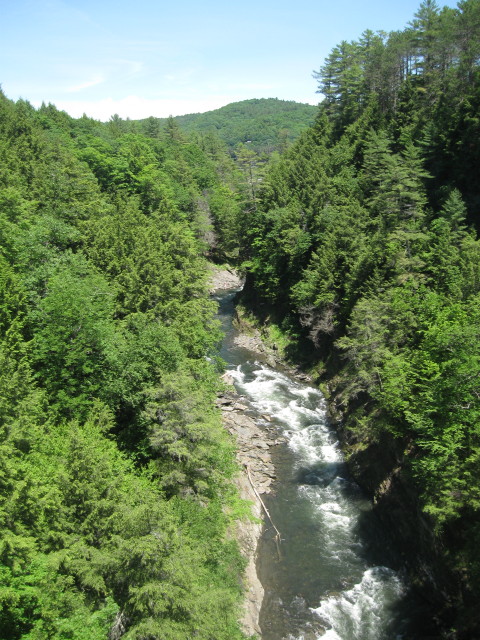
Looking up stream at the Ottauquechee River.
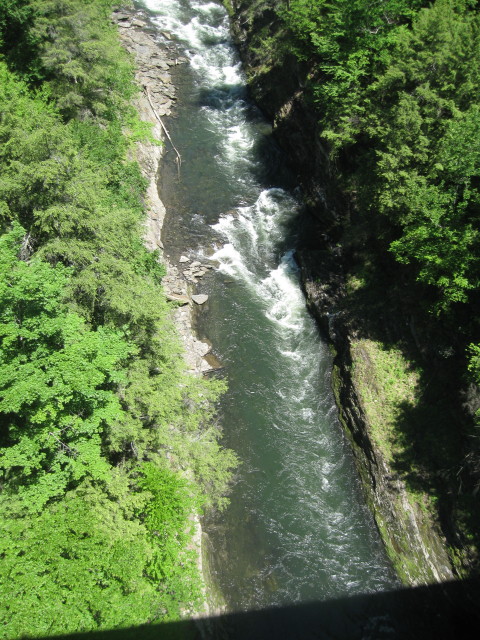
165 feet above the gorge.
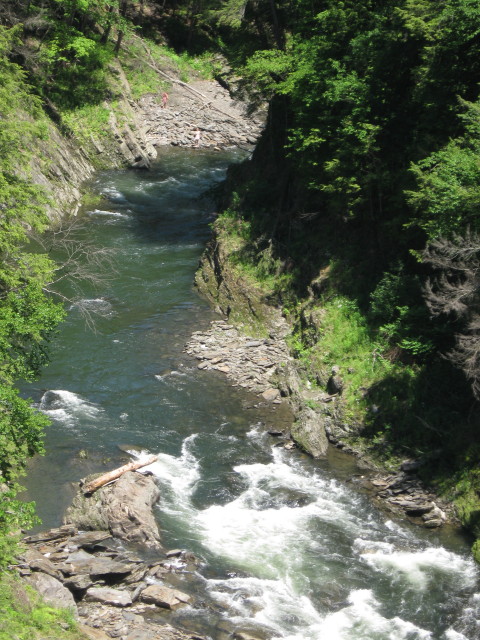
Girls playing on rocks in distance.
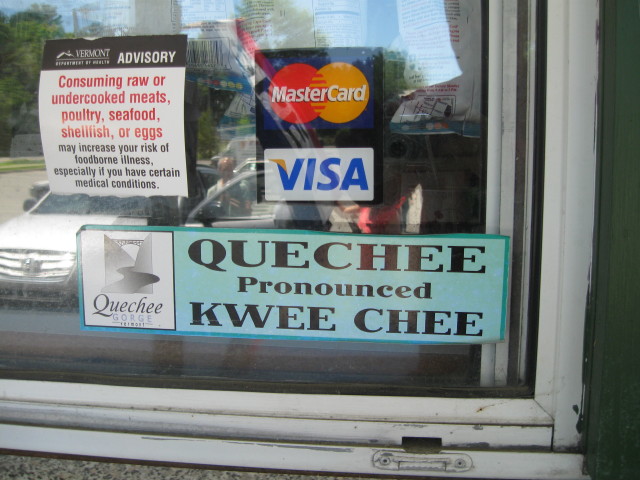
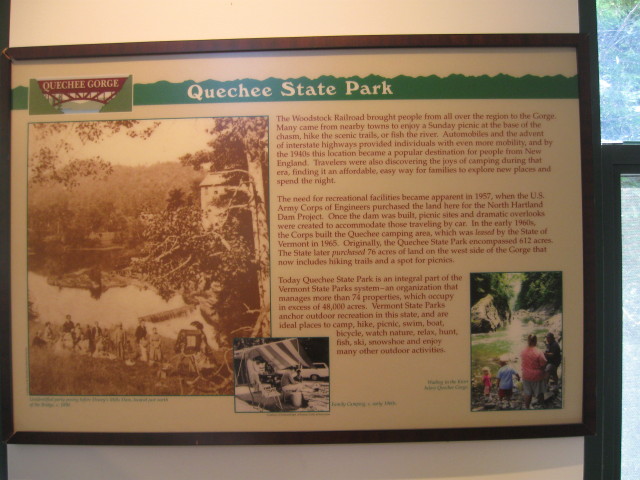
It was now 12:30 PM and time for lunch. Several
hundred feet from the bridge was a small snack bar
for ice cream and sandwiches. I looked at the menu,
found something I liked and ordered. As I waited and
talking to locals, who were also waiting for their
orders said that ice cream here was excellent. Guess
what's for dessert. The eating area was picnic
tables under shade of covered roof. I was joined by
Sarah Jennings and several other conventioneers. My
sandwich was tasty and messy and we ended up talking
about getting stains out of clothing. I got several
hints on getting red wine stains out of clothes.
After eating lunch, I walked next
door to the Quechee Gorge Village that was once a
small woollen mill town that has been turned into a
retail center. Leading the attractions are more than
a dozen well known stores.
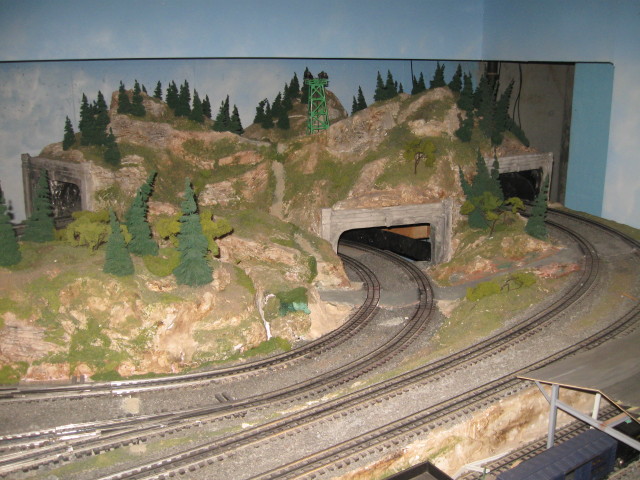
Display in the Vermont Toy & Train Museum.

I got my train fix for the day.
One of the most unusual
stores was the distillery that has sampling and retail
sales.
Weary of window shopping and tasting free
samples from the food vendors, we boarded the bus and
enjoyed the ride though the
verdant
and rural landscape to reach our final stop.
Calvin Coolidge State Historical Site and Homestead
District
This complex of more
than a dozen historic buildings is centered around a
modest frame and clapboard farmhouse, the childhood home
of the thirtieth President of the United States - Calvin
Coolidge - and the place where he took the presidential
oath of office. Today, the Coolidge Homestead is part of
the Calvin Coolidge State Historical Site, overseen by
the state of Vermont.
The home was bought by the father of
Calvin Coolidge and expanded it to its present size and
appearance. Coolidge lived there from age four (1876) to
1887, when he departed for Black River Academy in Ludlow for
education. Coolidge eventually earned a law degree and lived
most of his life in Northampton, Massachusetts. However, he
often returned to the home to visit his family. During one
visit while serving as vice president, Calvin Coolidge was
informed that President Harding had died. Therefore, at 2:47
AM on August 3, 1923, Vice President Calvin Coolidge became
the 30th President of the United States when he took the
oath of office in the sitting room of this modest frame and
clapboard farmhouse. Coolidge's father, a notary public,
administered the oath by the light of a kerosene lamp - the
family had refused to install such modern conveniences as
electricity. This refusal to modernize kept the house from
receiving many changes over the years, and much of it still
houses the same furniture that Coolidge used.
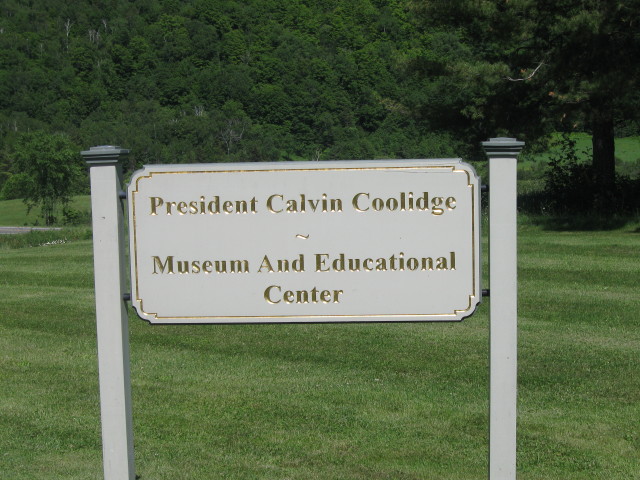
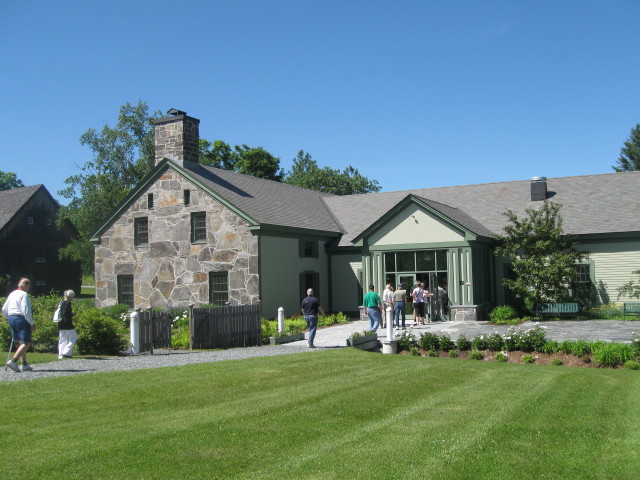
The President Calvin Coolidge Museum & Education Center
was dedicated in 2010. The building serves as the main
entrance to the historic site and has exhibits, meeting rooms,
museum store, classroom, and restrooms. A major
interactive, multimedia permanent exhibition,
More Than
Two Words: The Life and Legacy of Calvin Coolidge, highlights
Calvin Coolidge's life and accomplishments using his own
words, personal and historical objects, and period newsreels
to tell the story of how a boy from rural Plymouth Notch
became President of the United States.
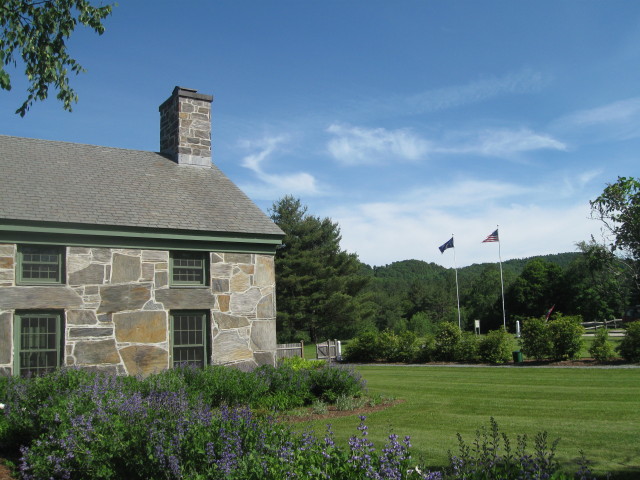
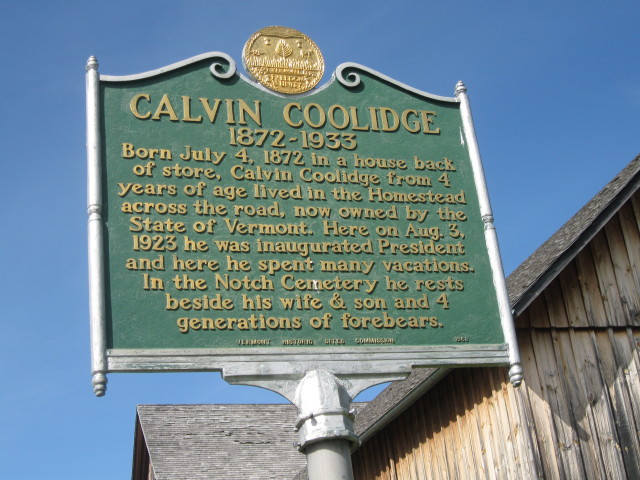
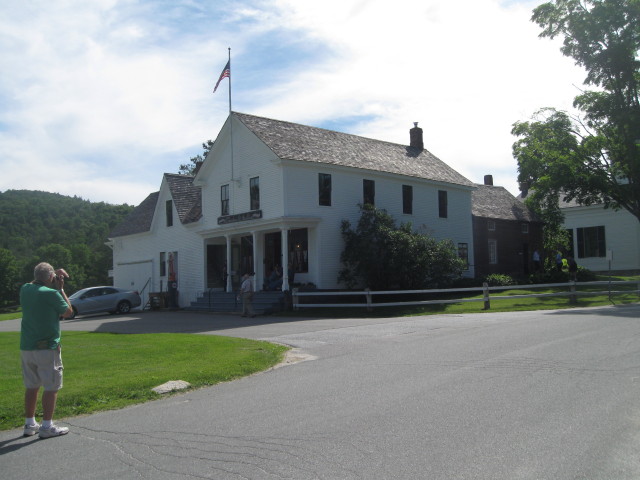
The Calvin Coolidge Birthplace is attached to the General
Store.
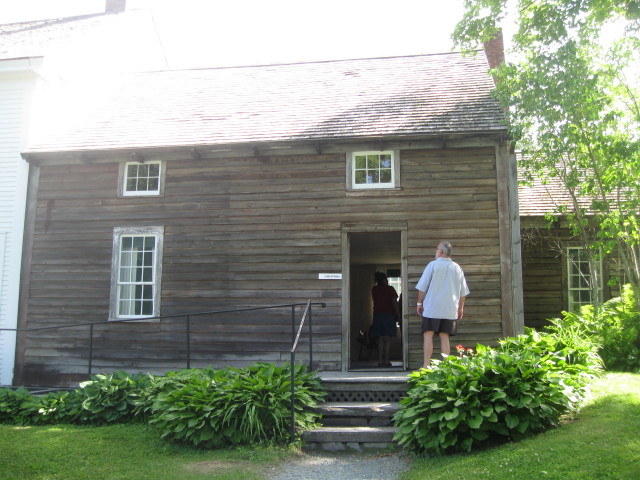
The Calvin Coolidge Birthplace.
Calvin Coolidge was born
in the downstairs bedroom on July 4, 1872. He was the first
child of John Calvin and Victoria Josephine Moor Coolidge.
His sister, Abigail, was born in 1875. The family lived in
this modest house until 1876 when they moved across the road
to what is now called the Coolidge Homestead.
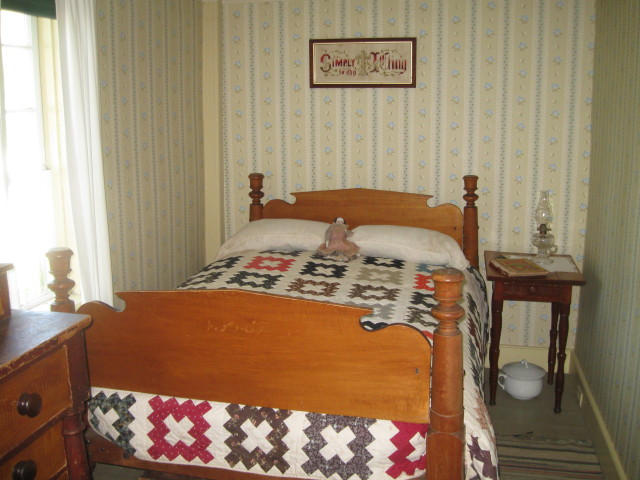
The Calvin Coolidge birthplace bedroom.
Unlike the other
buildings in Plymouth Notch, the Coolidge Birthplace was
extensively remodeled over the years. The Vermont
Division for Historic Preservation purchased the
building in 1968 and restored the Birthplace to its 1872
appearance. The Coolidge family donated the original
furnishings.
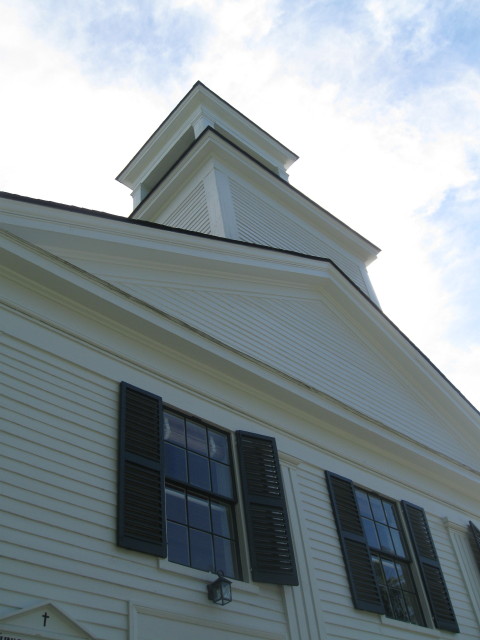
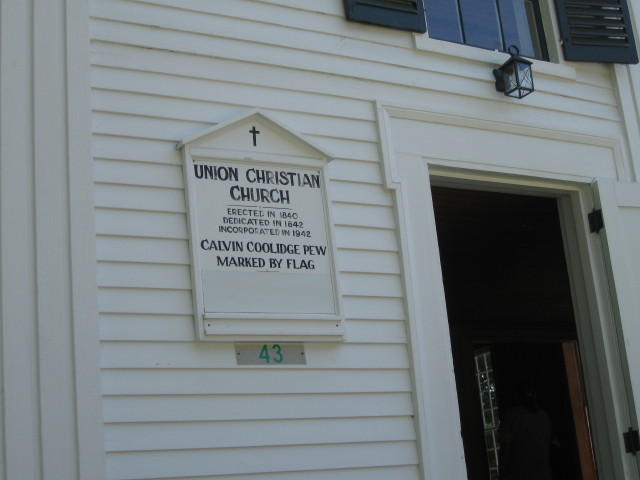
The Union
Christan Church was built in 1840 and dedicated as a
Congregational Church in 1842. It is in the Greek
Revival style. The original iron thresholds for the
front doors were cast at Tyson Furnace in the
southern part of the town of Plymouth.
Strawberry socials and baked bean
suppers were held to raise funds for funding repairs
in the 1890s. A local artisan, Willie Pierce,
redesigned the interior in Carpenter Gothic style.
The hard pine for the woodwork was sawn at a local
mill.The interior offered perfect acoustics for the
new Estey pump organ, and the church was rededicated
in 1900.
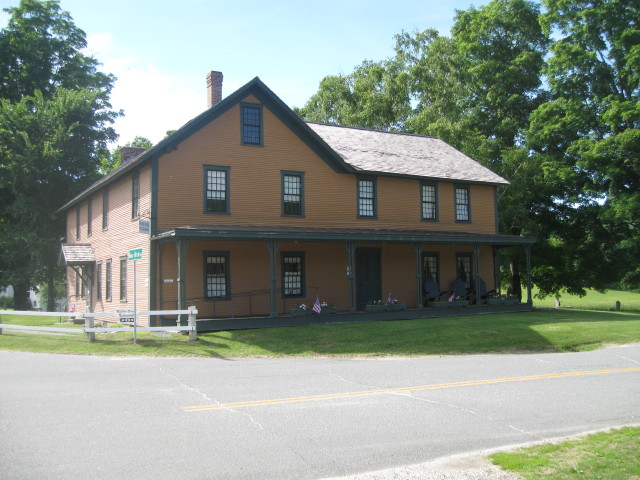
The Wilder House.
The Wilder House,
originally a tavern built around 1830, was the childhood
home of President Coolidge's mother, Victoria Josephine
Moor. Victoria married John Coolidge in the front sitting
room in 1868. Her sister and brother-in-law, Gratia and John
Wilder, lived in the house in later years. The building's
exterior is painted as it was in the 1920s with a
distinctive mustard-gold and green color scheme. The
interior was remodeled as a coffee shop in 1956. It is now
the site restaurant, serving breakfast and lunch during the
season.

The Wilder Barn
The Wilder Barn was once
part of the Moor-Wilder Farm. Built c. 1875, it is a "bank
barn" -- built into the side, or bank, of a slope so that it
could be easily entered on two levels. Typically, hay was
stored overhead, the dairy herd was on the main floor, and
the basement was for other livestock and manure storage. The
hand-hewn beams are pegged together, and the exterior is
clad with unpainted vertical pine boards with narrow
battens. The Wilder Barn now exhibits an extensive
collection of agricultural equipment used on a typical
hillside farm at the turn of the 20th century.
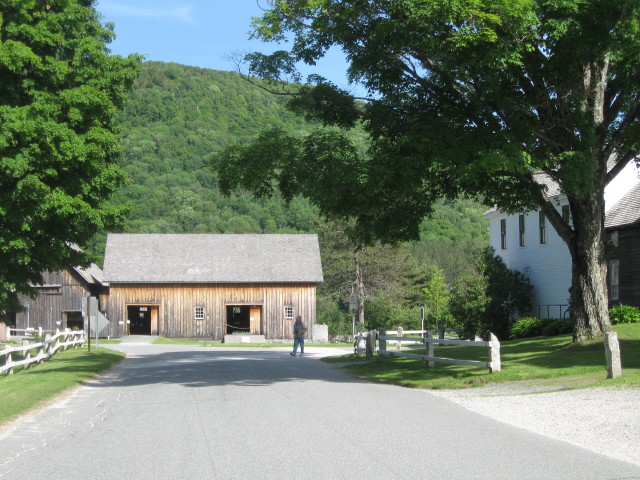
The Wilder Horse Barn in center with Wilder Barn to the
left, general store on far right.
The Wilder Horse Barn, reconstructed in 2003, is a
recreation of the original c. 1875 barn that was torn
down in the mid-20th century. This accurate
reconstruction was possible because nearly every angle
of the building was photographed in the 1920s. Similar
to the adjacent main barn, this is a post and beam "bank
barn." Some of the site's collection of horse drawn
vehicles are displayed on the main level: the lower
level has restrooms and a picnic area.
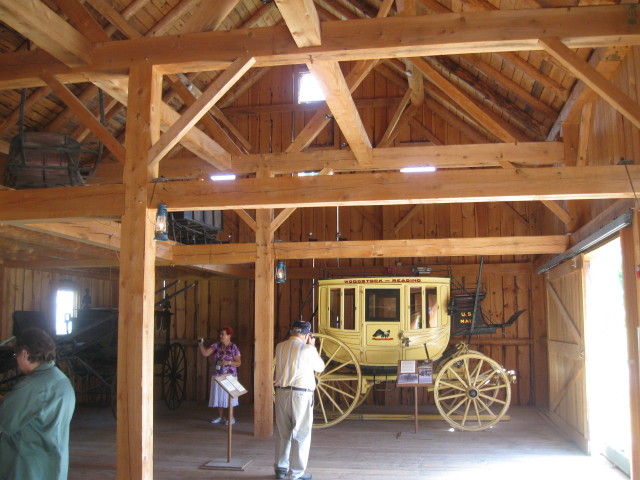
Collection inside the Wilder Horse Barn.
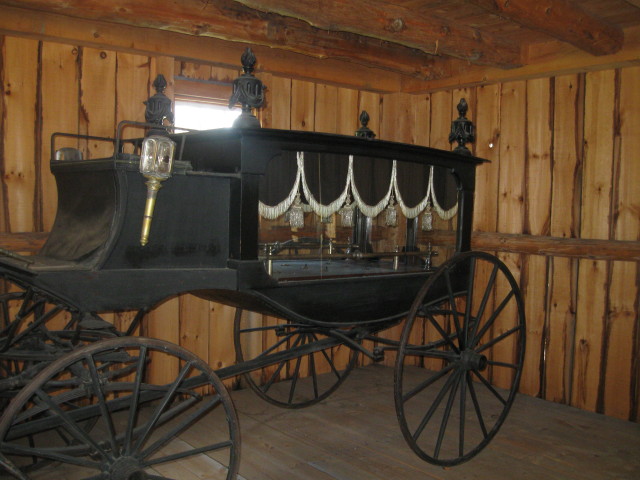
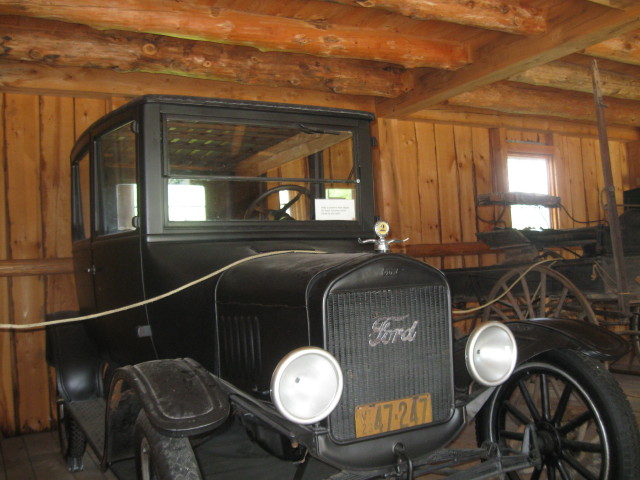
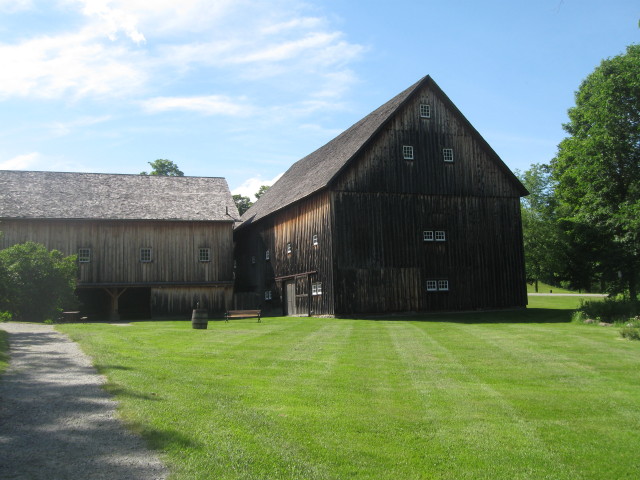
Back view of the barns.
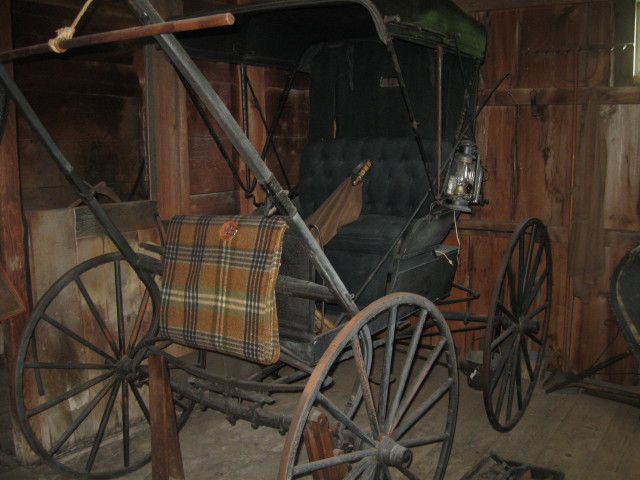
Family buggy at the Coolidge Homestead.
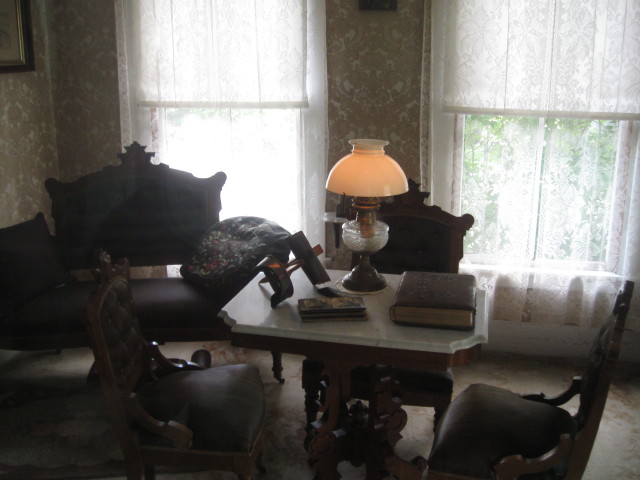
The Inaugural Room.
The Inaugural
Room, also known as the "Oath of Office Room," was
once the sitting room and is today displayed behind
glass, but a visitor can stand in an alcove and see
the lamp, Bible, and table that were used in the
ceremony, all placed in their historic positions. It
was while vacationing here that Vice President
Coolidge received word of the unexpected death of
President Warren Harding. Colonel John Coolidge, a
notary public, administered the presidential
oath of office to his son at 2:47 AM on August 3,
1923. Years later, an inquisitive visitor asked
Colonel Coolidge, "How did you know you could
administer the presidential oath to your own son?"
The laconic Vermonter replied, "I didn't know that I
couldn't."
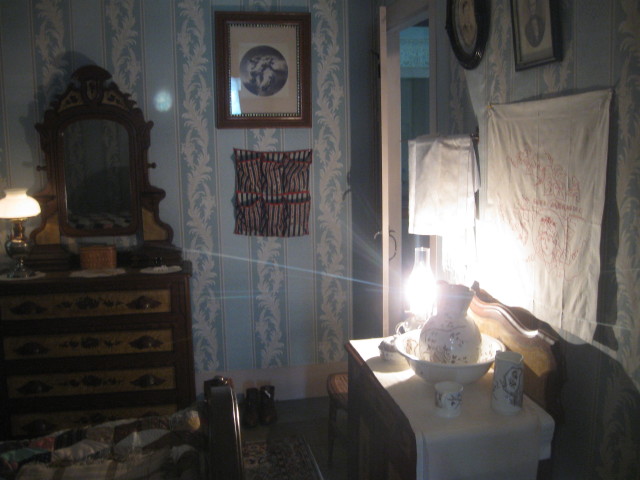
The President's bedroom.
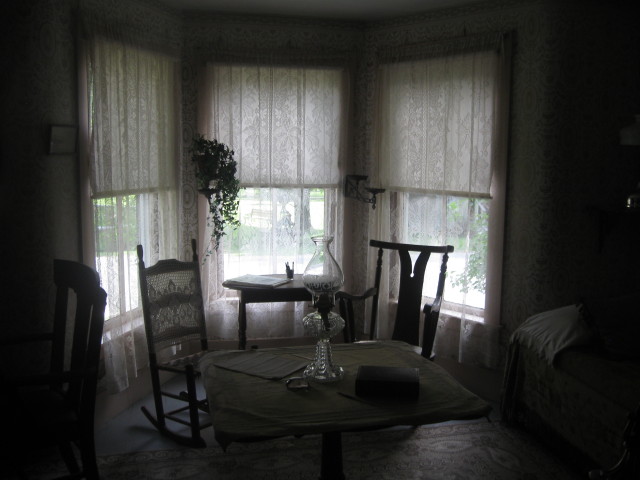
Parlor room.
Upon leaving the Coolidge
Homestead, we were greeted by a sheep shearing demonstration
in the side yard. The demonstrator was only using a manual
sheer.
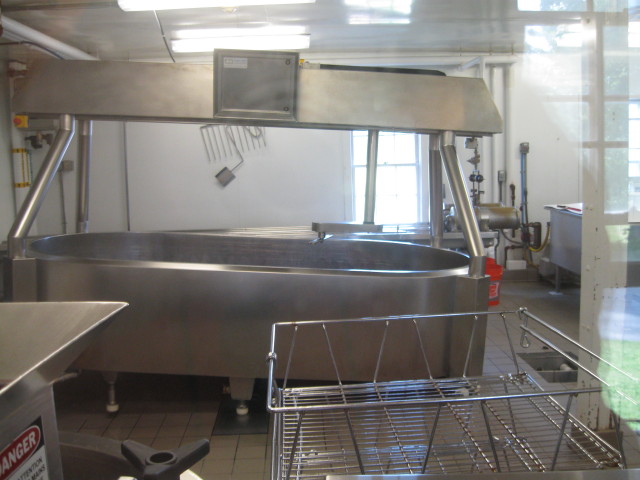
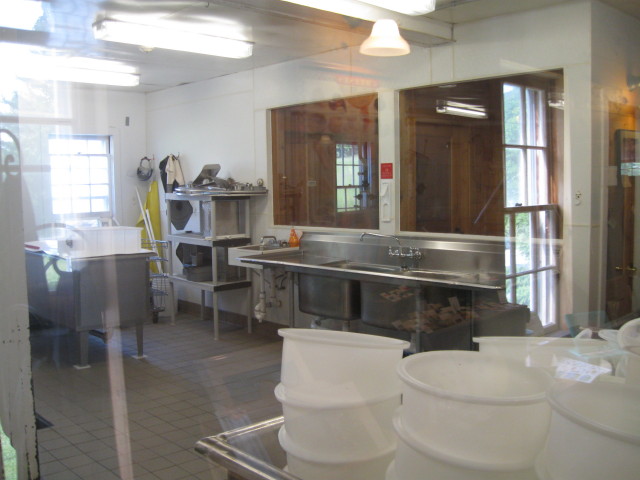
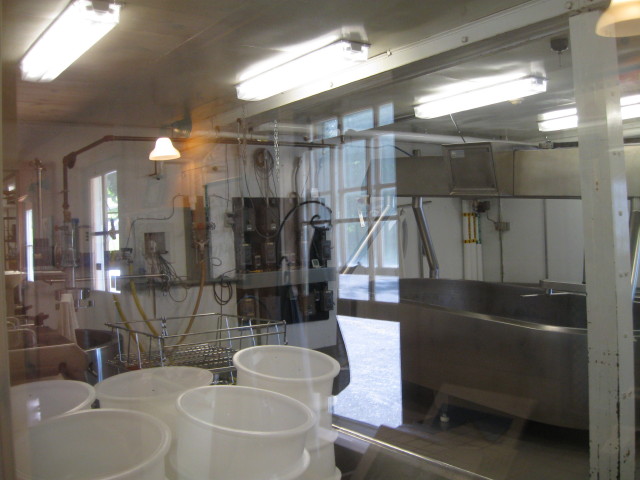
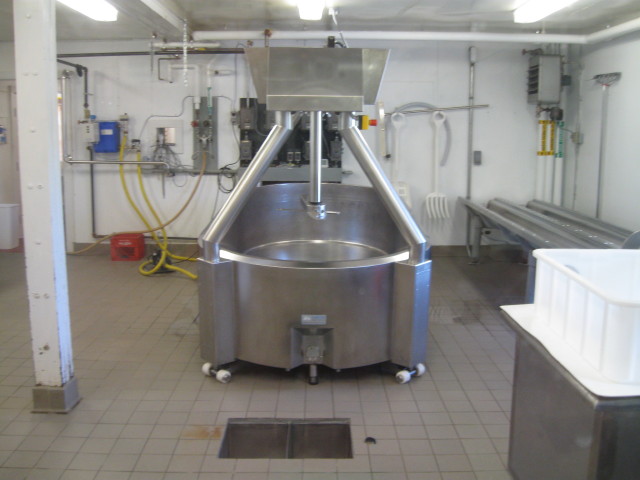
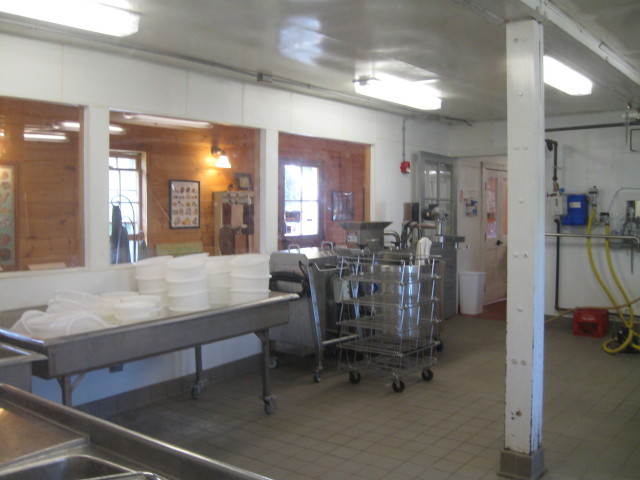
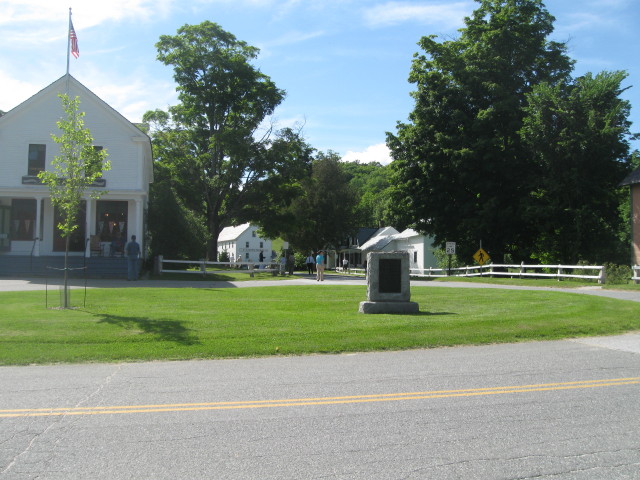
Left to right: General Store and Birthplace home, The
Plymouth Cheese Factory, The Coolidge Homestead and far
right, The Wilder House.
Photo taken standing in front of the barns.
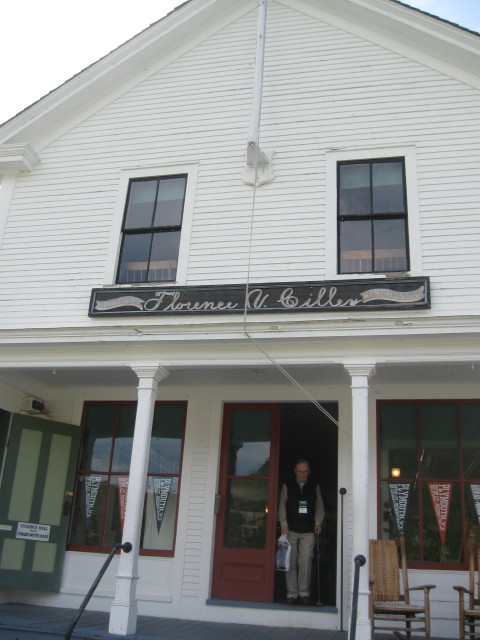
The Florence Cilley
General Store was built during the 1850s. John Coolidge,
the President's father, became storekeeper in 1868. The
rent was $40 a year, and by careful management profits
averaged $100 a month. Coolidge soon purchased the store
and entered into partnership with his wife's brother in
1875. He sold his share of the business in 1877, but
owned the building until 1917. Florence Ciley, whose
named appears above the front door, operated the store
between 1917 and 1945. The small post office at the
front of the stores served the town until 1976. The
Plymouth Post Office, located in the former carriage
barn attached to the General Store, is an operating
United States Post Office.
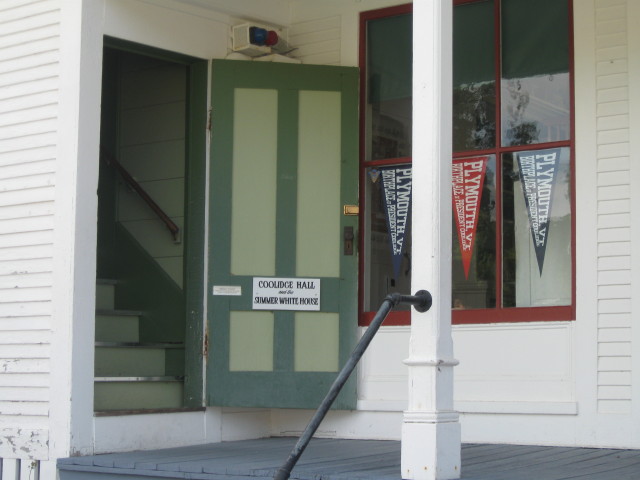
Coolidge Hall,
the large vaulted room above the General Store, was
used by the Grange for weekly dances and family
reunions well into the 20th century. It became
famous when it served as President Coolidge's Summer
White House in 1924. The hall has its original
furnishings including tables made especially for the
President and instruments of the "Plymouth Old Time
Dance Orchestra."
As it was near closing time at
this state historic site, we started boarding our
bus for the ride back to the hotel. It had been a
long and busy day.
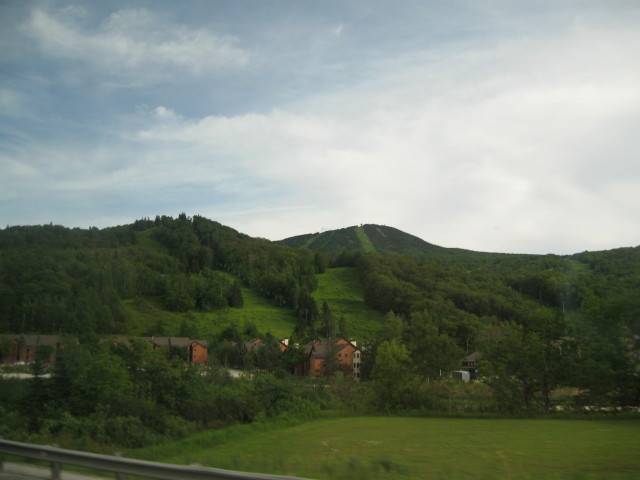
Ski trails cut into
green
forest on Pico Mountain in
Killington, VT.
Arriving at the hotel
at dinner time, Chris and I decided to give the
Ponderosa Steakhouse, a short walk away, another go.
Tonight I did the buffet. Again we chatted and visited
with fellow conventioneers.
After our repast it was time to walk
back to the motel.
Tomorrow we are going to ride a
train. Yea! Going to Lake Champlain !!!
For More Information
Web
Sites:
King Arthur Flour
Blake Hill Preserve
Simon Pearce
Glassblowing
Quechee
Gorge State Park
Vermont Spirits
Calvin
Coolidge Historic Homestead
Click BACK button
on your browser to return to this page.
The author retains all rights. No reproductions are
allowed without the author's consent.
Comments are appreciated at... yr.mmxx@gmail.com
 Click to see video
of falls.
Click to see video
of falls.